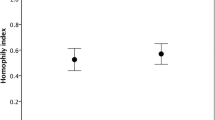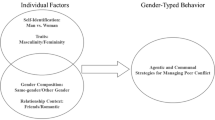Abstract
Heterosexual U.S. adolescents tend to show gender differences in how they describe romantic relationships, with males being positioned as cool and objectifying toward females, and females as warm and positively engaged (Simon et al. 1992; Tolman 2002). However, according to developmental theory (Arnett 2000, 2004), such gender scripts should be less operative in early adulthood, when romantic relationships become a prime concern for college-age youth regardless of gender. Partly confirming this premise, a recent study of male undergraduate friends in California found that during casual conversations, one of their most prevalent story telling patterns was shifting between positioning themselves as warm and engaged (intimate) and as cool and objectifying (distancing) toward romantic partners (Korobov and Thorne 2006). For purposes of a gender comparison, the present archival, mixed-methods study deployed the same methodology to examine the prevalence of these patterns for a companion college sample of 37 pairs of women friends. Gender differences were found for only one of four story patterns: Women friends told proportionately more stories than men that were mildly intimate. Otherwise the stories of both genders showed parallel patterns either of dense distancing, or of repeatedly shifting between intimacy and distancing. In addition, women and men friends showed a similar versatility in the array of patterns they produced. The findings suggest mild operability of a gendered intimacy script, but more generally support the premise that working out what one does and doesn’t want in a romantic relationship is a common concern for young adult friends regardless of gender.

Similar content being viewed by others
References
Arnett, J. J. (2000). Emerging adulthood: A theory of development from the late teens through the twenties. American Psychologist, 55, 469–480. doi:10.1037/0003-066X.55.5.469.
Arnett, J. J. (2004). Emerging adulthood: The winding road from late teens through the twenties. New York: Oxford University Press.
Bamberg, M. (2004a). “I know it may sound mean to say this, but we couldn’t really care less about her anyway”. Form and functions of “slut bashing” in male identity constructions in 15-year-olds. Human Development, 47, 331–353. doi:10.1159/000081036.
Bamberg, M. (2004b). Talk, small stories, and adolescent identities. Human Development, 47, 366–369. doi:10.1159/000081039.
Bamberg, M., & Georgakopoulou, A. (2008). Small stories as a new perspective in narrative and identity analysis. Text & Talk, 28, 377–396. doi:10.1515/TEXT.2008.018.
Brown, B. B. (1999). “You’re going out with who?”: Peer group influences on adolescent romantic relationships. In W. Furman, B. B. Brown, & C. Feiring (Eds.), The development of romantic relationships in adolescence (pp. 291–329). Cambridge: Cambridge University Press.
Bruner, J. (1990). Acts of meaning. Cambridge: Harvard University Press.
Bryant, A. N. (2003). Changes in attitudes toward women’s roles: Predicting gender role traditionalism among college students. Sex Roles, 48, 131–142. doi:10.1023/A:1022451205292.
Burns, A. (2000). Looking for love in intimate heterosexual relationships. Feminism & Psychology, 10, 481–485. doi:10.1177/0959353500010004008.
Connell, R. W. (1987). Gender and power: Society, the person and sexual politics. Stanford: Stanford University Press.
Connolly, J. A., & Goldberg, A. (1999). Romantic relationships in adolescence: The role of friends and peers in their emergence and development. In W. Furman, B. B. Brown, & C. Feiring (Eds.), The development of romantic relationships in adolescence (pp. 266–290). Cambridge: Cambridge University Press.
Erikson, E. (1968). Identity: Youth and crisis. England: Norton & Co.
Feiring, C. (1999). Gender identity and the development of romantic relationships in adolescence. In W. Furman, W. Furman, B. B. Brown, & C. Feiring (Eds.), The development of romantic relationships in adolescence (pp. 211–232). Cambridge: Cambridge University Press.
Fine, M. (1988). Sexuality, schooling, and adolescent females: The missing discourse of desire. Harvard Educational Review, 58, 29–53.
Furman, W. (2002). The emerging field of adolescent romantic relationships. Current Directions in Psychological Science, 11, 177–180. doi:10.1111/1467-8721.00195.
Giedd, J. N., Raznahan, A., Lee, N. R., Weddle, C., Liverpool, M., Stockman, M., et al. (2011). Structural brain magnetic resonance imaging of typically developing children and adolescents. In E. Amsel & J. Smetana (Eds.), Adolescent vulnerabilities and opportunities: Developmental and constructivist perspectives (pp. 23–40). New York: Cambridge University Press.
Goffman, E. (1977). The arrangement between the sexes. Theory and Society, 4, 301–331. doi:10.1007/BF00206983.
Gottman, J. M., Levenson, R. W., Swanson, C., Swanson, K., Tyson, R., & Yoshimoto, D. (2003). Observing gay, lesbian, and heterosexual couples’ relationships: Mathematical modeling of conflict interaction. Journal of Homosexuality, 45, 65–91. doi:10.1300/J082v45n01_04.
Griffin, C. (2000). Absences that matter: Constructions of sexuality in studies of young women’s friendships. Feminism & Psychology, 10, 227–245. doi:10.1177/0959353500010002003.
Habermas, T., & de Silveira, C. (2008). The development of global coherence in life narratives across adolescence: Temporal, causal, and thematic aspects. Developmental Psychology, 44, 707–721. doi:10.1037/0012-1649.44.3.707.
Hartup, W. W. (1993). Adolescents and their friends. In B. Laursen (Ed.), Close friendships in adolescence (pp. 3–22). San Francisco: Jossey-Bass.
Henley, N. M. (1985). Psychology and gender. Signs: Journal of Women in Culture and Society, 11, 101–119. doi:10.1086/494202.
Hess, N. H., & Hagen, E. H. (2006). Sex differences in indirect aggression: Psychological evidence from young adults. Evolution and Human Behavior, 27, 231–245. doi:10.1016/j.evolhumbehav.2005.11.001.
Hey, V. (1997). The company she keeps. An ethnography of girls’ friendship. Buckingham: Open University Press.
Jackson, S. (2001). Happily never after: Young women’s stories of abuse in heterosexual love relationships. Feminism & Psychology, 11, 305–321. doi:10.1177/0959353501011003004.
Jackson, S. (2005). ‘I’m 15 and desperate for sex”: ‘Doing’ and ‘undoing’ desire in letters to a teenage magazine. Feminism & Psychology, 15, 295–313. doi:10.1177/0959-353505054717.
Jackson, S., & Cram, F. (2003). Disrupting the sexual double standard: Young women’s talk about heterosexuality. British Journal of Social Psychology, 42, 113–127. doi:10.1348/014466603763276153.
Kirkman, M., Rosenthal, D., & Smith, A. M. A. (1998). Adolescent sex and the romantic narrative: Why some young heterosexuals use condoms to prevent pregnancy but not disease. Psychology, Health & Medicine, 3, 355–370. doi:10.1080/13548509808400610.
Korobov, N., & Thorne, A. (2006). Intimacy and distancing: Young men’s conversations about romantic relationships. Journal of Adolescent Research, 21, 27–55. doi:10.1177/0743558405284035.
Korobov, N., & Thorne, A. (2009). The negotiation of compulsory romance in young women friends’ stories about romantic heterosexual experiences. Feminism & Psychology, 19, 49–70. doi:10.1177/0959353508098619.
Korobov, N., Thorne, A., Norona, J. C., & Farwood, H. B. (2011). Manual for coding intimate and distancing positions in narratives about romantic relationships. Unpublished manuscript, University of California, Santa Cruz.
Kurdek, L. A. (1998). Relationship outcomes and their predictors: Longitudinal evidence from heterosexual married, gay cohabitating, and lesbian cohabitating couples. Journal of Marriage and Family, 60, 553–568. doi:10.2307/353528.
Labov, W., & Waletzky, J. (1967). Narrative analysis: Oral versions of personal experience. In J. Helm (Ed.), Essays on the verbal and visual arts (pp. 12–44). Seattle: University of Washington Press.
Leaper, C., & Ayres, M. M. (2007). A meta-analytic review of gender variations in adults’ language use: Talkativeness, affiliative speech, and assertive speech. Personality and Social Psychology Review, 11, 328–363. doi:10.1177/1088868307302221.
Montgomery, M., & Côté, J. E. (2003). College as a transition to adulthood. In G. R. Adams & M. D. Berzonsky (Eds.), Blackwell handbook of adolescence. Blackwell handbooks of developmental psychology (pp. 149–172). Malden: Blackwell.
Ochs, E., & Capps, L. (2001). Living narrative: Creating lives in everyday storytelling. Cambridge: Harvard University Press.
Phillips, L. (2000). Flirting with danger: Young women’s reflections on sexuality and dominance. New York: New York University Press.
Rich, A. (1983). Compulsory heterosexuality and lesbian existence. In A. Snitow, C. Stansell, & S. Thompson (Eds.), Powers of desire: The politics of sexuality (pp. 177–205). New York: Monthly Review Press.
Robinson, T., & Ward, J. (1991). A belief far greater than one’s disbelief: Cultivating resistance among African American female adolescents. In C. Gilligan, A. G. Rogers, & D. L. Tolman (Eds.), Women, girls, and psychotherapy: Reframing resistance (pp. 87–104). New York: Harrington Park Press.
Rose, A. J. (2002). Co-rumination in the friendships of girls and boys. Child Development, 73, 1830–1843. doi:10.1111/1467-8624.00509.
Simon, R. W. (2002). Revisiting the relationships among gender, marital status, and mental health. The American Journal of Sociology, 107, 1065–1096. doi:10.1086/339225.
Simon, R. W., Eder, D., & Evans, C. (1992). The development of feeling norms underlying romantic love among adolescent females. Social Psychology Quarterly, 55, 29–46. doi:10.2307/2786684.
Solomon, D. H., & Knobloch, L. K. (2004). A model of relational turbulence: The role of intimacy, relational uncertainty, and interference from partners in appraisals of irritations. Journal of Social and Personal Relationships, 21, 795–816. doi:10.1177/0265407504047838.
Taylor, J. M., Gilligan, C., & Sullivan, A. M. (1995). Between voice and silence: Women and girls, race and relationship. Cambridge: Harvard University Press.
Thompson, S. (1995). Going all the way: Teenage girls’ tales of sex, romance, and pregnancy. New York: Hill and Wang.
Thorne, A., Korobov, N., & Morgan, E. M. (2007). Channeling identity: A study of storytelling in conversations between introverted and extraverted friends. Journal of Research in Personality, 41, 1008–1031. doi:10.1016/j.jrp.2006.12.001.
Thorne, A., Shapiro, L., Cardilla, K., Korobov, N., & Nelson, P. A. (2009). Caught in the act: How extraverted and introverted friends communally cope with being recorded. Journal of Research in Personality, 43, 634–642. doi:10.1016/j.jrp.2009.03.014.
Tolman, D. L. (2002). Dilemmas of desire: Teenage girls talk about sexuality. Cambridge: Harvard University Press.
Tolman, D. L. (2006). In a different position: Conceptualizing female adolescent sexuality development within compulsory heterosexuality. New Directions for Child and Adolescent Development, 2006, 71–89. doi:10.1002/cd.163.
Tolman, D. L., & Porche, M. V. (2000). The Adolescent Femininity Ideology Scale: Development and validation of a new measure for girls. Psychology of Women Quarterly, 24, 365–376. doi:10.1111/j.1471-6402.2000.tb00219.x.
Tolman, D. L., Spencer, R., Rosen-Reynoso, M., & Porche, M. V. (2003). Sowing the seeds of violence in heterosexual relationships: Early adolescents narrate compulsory heterosexuality. Journal of Social Issues, 59, 159–178. doi:10.1111/1540-4560.t01-1-00010.
Umberson, D., Chen, M. D., House, J. S., Hopkins, K., & Slaten, E. (1996). The effect of social relationships on psychological well-being: Are men and women really so different? American Sociological Review, 61, 837–857. doi:10.2307/2096456.
Walkerdine, V. (1990). Schoolgirl fictions. London: Verso.
Williams, K. (2003). Has the future of marriage arrived? A contemporary examination of gender, marriage, and psychological well-being. Journal of Health and Social Behavior, 44, 470–487. doi:10.2307/1519794.
Author information
Authors and Affiliations
Corresponding author
Appendix A
Appendix A
Rights and permissions
About this article
Cite this article
Norona, J.C., Thorne, A., Kerrick, M.R. et al. Patterns of Intimacy and Distancing as Young Women (and Men) Friends Exchange Stories of Romantic Relationships. Sex Roles 68, 439–453 (2013). https://doi.org/10.1007/s11199-013-0262-7
Published:
Issue Date:
DOI: https://doi.org/10.1007/s11199-013-0262-7




